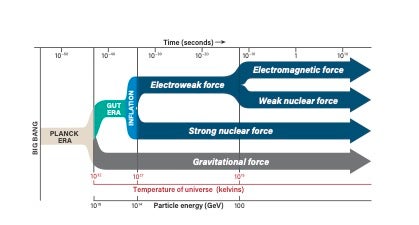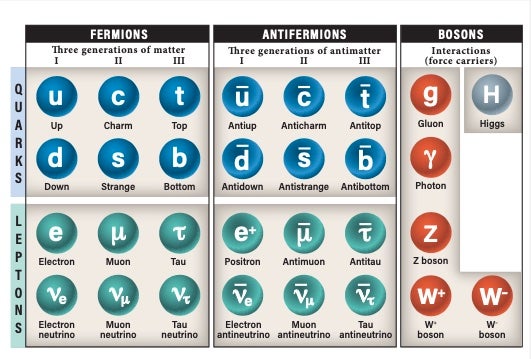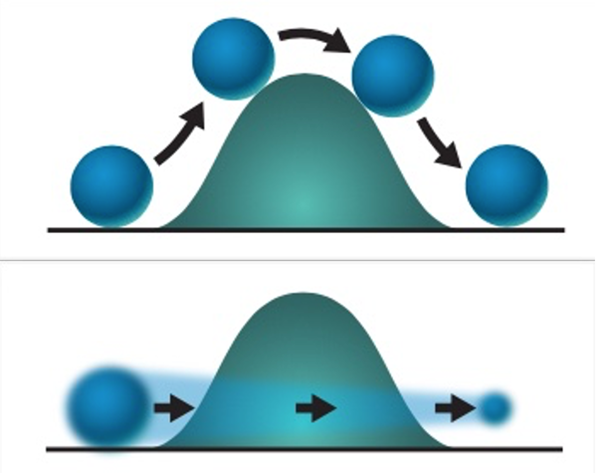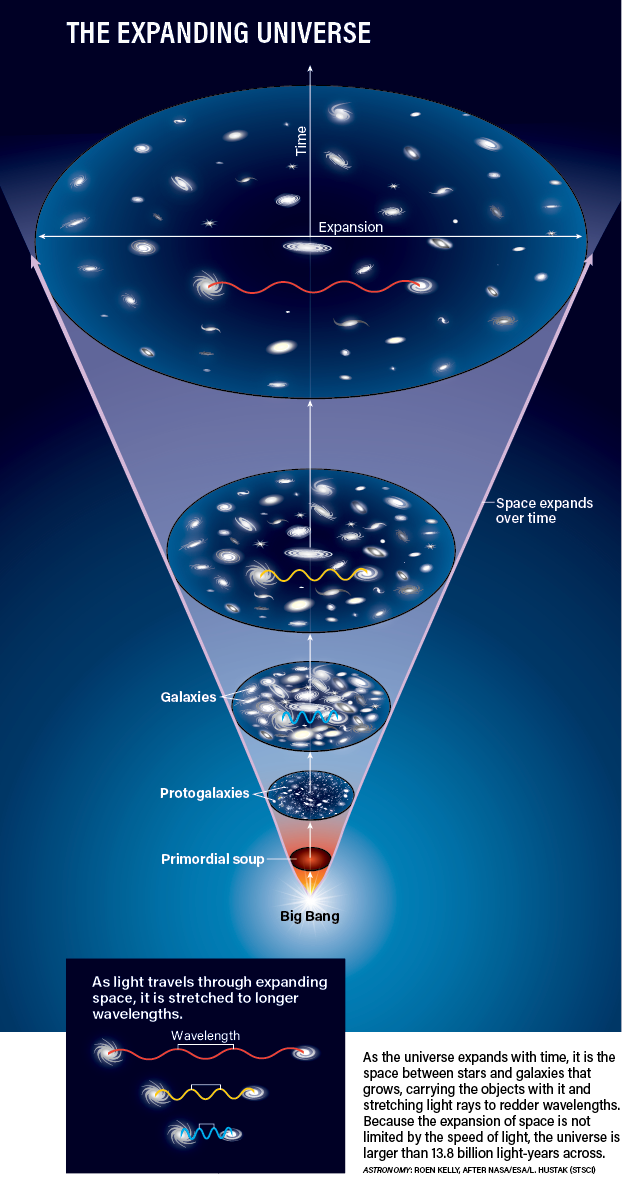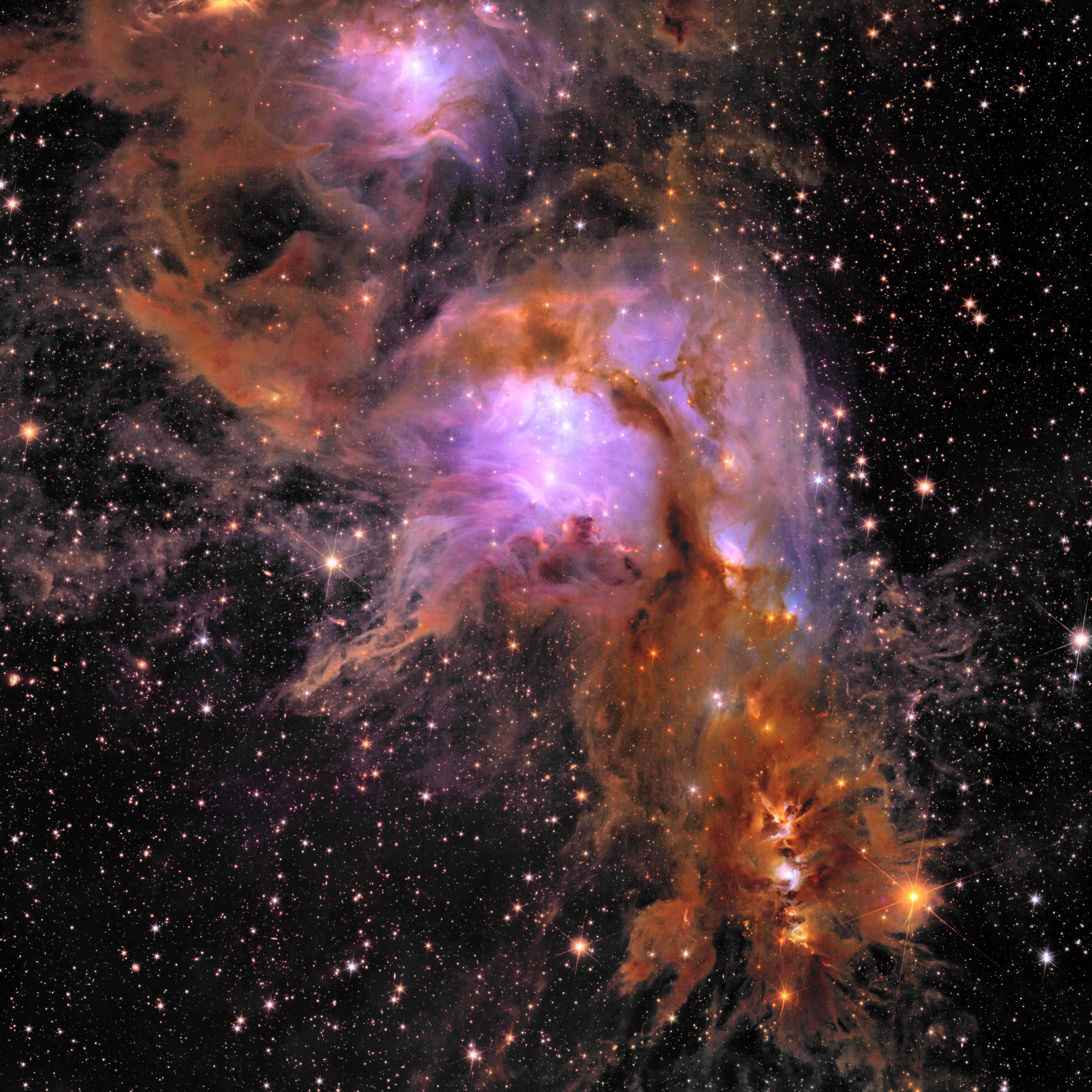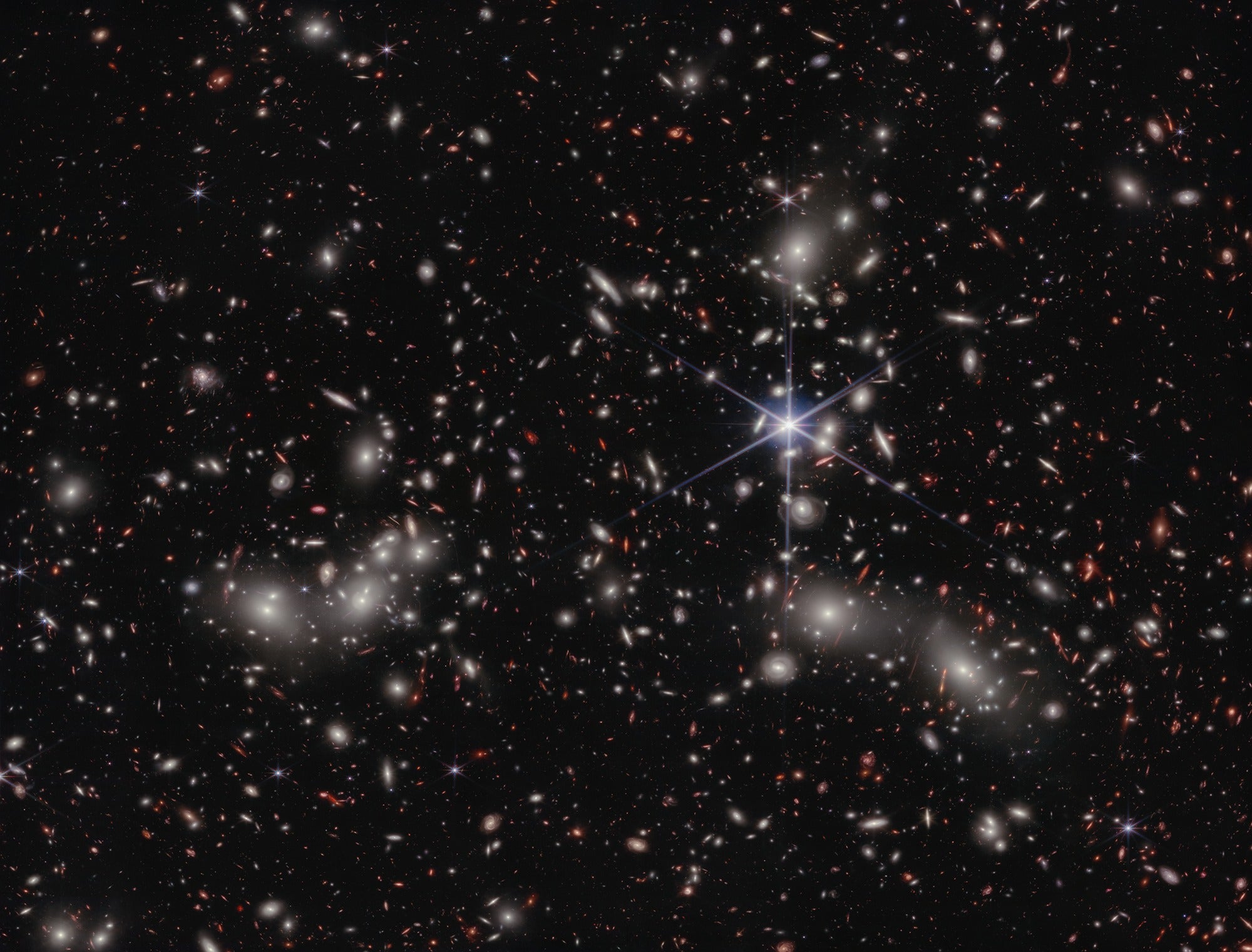In less time than it takes to snap your fingers, the universe flashed into existence.
Cosmogenesis is the breathtaking story of how this happened. It includes, in its later moments, the creation of the primordial elements and depicts their organization by dark matter and gravity into vast cosmic structures on the largest scales. Meanwhile, on smaller scales, local gravitational collapse created stars and, later, planets.
The prelude to this story began with a major cosmological event: inflation. Between 10-36 and 10-34 seconds after the Big Bang, the physical scale of our universe doubled in size more than 50 times, so that by today, it is trillions of times larger than the 14 billion-light-year extent we can observe.
Inflation’s effects shaped the cosmos we see today: geometrically flat, homogeneous, and with the right mix of matter and energy. But what happened before inflation? The answer takes us deep into the nature of reality itself, and face to face with a time called the Planck era.
The GUT era
To probe the Planck era, we must first bridge an equally mysterious period called the GUT era.
The period of cosmic history before inflation kicked off, ranging from 10-43 to 10-36 seconds after the Big Bang, is almost unimaginable. But we think its properties are nevertheless calculable. During this time, gravity had become its own distinct force, but those forces we now experience individually as the separate strong, weak, and electromagnetic forces were all essentially indistinguishable.
There are many ways this unification could happen, each advocated as a separate theory. Collectively these are called Grand Unification Theories or GUTs. The simplest GUTs propose the existence of families of supermassive particles of 1014 gigaelectronvolts (GeV) or more. They are partners to our familiar Standard Model particles, which have masses from 0 to about 150 GeV.
The temperature and density of the cosmos during the GUT era was unimaginably gargantuan: 1028 kelvins and 1080 grams per cubic centimeter. (For comparison, a neutron star has a density of about 1015 g/cm3.) Typical distances between particles were 10-26 cm or less. What’s more, particles simply popped in and out of existence in matter-antimatter pairs from out of their respective quantum fields. At this energy scale, where typical particle energies were above 1015 GeV — namely, those of the supermassive GUT particles — the familiar Standard Model particles were essentially massless by comparison. They behaved more like photons.
The comings and goings of the supermassive GUT particles tossed the gravitational field of the universe about like waves on a stormy sea. Space and time themselves were warped by the many sudden changes in this turbulent gravitational field.
The GUT era was indeed an incomprehensible, fluctuating, hot mess of interacting particles and fields. Physicists believe these messy conditions continued all the way down to a scale of 10-33 cm and time intervals of 10-43 seconds, called the Planck size and time. The Planck scale, whether referring to size, time, mass, or otherwise, is the smallest unit of the universe we can describe — or, perhaps, that even exists. Below these scales, our current theories about space and time completely break down. If we try to describe the universe at a time before 10-43 seconds in its history — the Planck era — we discover that both time and space lose their conventional meaning.
The nature of time and space
The reason our descriptions of time and space break down near the Planck era is that the gravitational field at this time was so distorted and turbulent with its own quantum fluctuations, it is impossible to define a clock to measure time or a ruler to measure length. Only a fully quantum mechanical description of gravity — which we don’t yet have — will let us probe deeper into this corner of cosmic history.
If we could examine physics at the Planck scale today, we would see what this quantum chaos is like. But at this scale, nature defeats our best efforts to observe it at all.
If you try to study the gravitational field of the cosmos down to 10-33 cm using a photon, its energy would have to be so high (1019 GeV) that it would immediately (after 10-43 seconds, the Planck time) become a tiny, quantum black hole with the smallest possible mass and event horizon radius: 10-5 gm and 10-33 cm (the Planck mass and size). The black hole would then evaporate and destroy the very information you were trying to extract.
Since the 1930s, physicists have preferred to think of gravity and the way it acts on matter and energy as simply another name for space-time. In Einstein’s theory of general relativity, space-time in the guise of the gravitational field provides the coordinates in space and time (x, y, z, t) that quantum mechanics needs to describe all the other fields corresponding to the Standard Model particles. General relativity provides what physicists call a background-independent way to define space and time as a collection of fundamental events and the relationships between them.
Quantum mechanics, on the other hand, requires the pre-existence of these coordinates to define fields, which means it is a background-dependent theory. To make general relativity and quantum mechanics play together, quantum mechanics must be rebuilt in terms of coordinates defined only by the gravitational field.
Despite a century of effort, physicists still do not have such a quantum theory for gravity that reproduces our universe at both quantum and cosmic scales. What’s more, not a single observation suggests that gravity has to be quantized at all. Richard Feynman once noted: “The extreme weakness of quantum gravitational effects now poses some philosophical problems: maybe nature is trying to tell us something new here, maybe we should not try to quantize gravity.”
But that doesn’t stop physicists from trying to do it!
Quantizing gravity
Treating gravity as just another quantum field like the ones in the Standard Model would complete our description of the physical world as a set of interacting quantum fields. Most physicists consider such a theory the epitome of beauty and elegance. Quantum gravity theory currently takes two popular, complementary forms: superstring theory (also simply called string theory) and loop quantum gravity.
In string theory, Standard Model particles are represented as one-dimensional strings of energy that move and vibrate within an 11-dimensional arena called the Bulk. Strings can either be open with two ends, like a piece of spaghetti, or closed like a rubber band. Different vibrations of these strings in seven compact dimensions represent each type of particle in the Standard Model.
Open strings are anchored at each end on three-dimensional objects called branes. Confined within just one of these branes — the one that comprises our particular universe — are all the Standard Model particles and hopefully a few more, such as those we suspect are responsible for dark matter, dark energy, and inflation. Closed strings, meanwhile, represent gravitons, which are the fundamental particles, or quanta, of the gravitational field. These are free to move across all dimensions of the Bulk.
A three-dimensional brane represents one possible state of 3D space at a specific instant — a snapshot of the universe. As time ticks by, it generates a collection of branes, like the successive pages in a book, that represent our entire four-dimensional universe.
But like current quantum theory, string theory relies on the pre-existence of space-time and does not (as yet) provide insight into gravity as a quantum field. Strings provide no clues to how to interpret the space-time they are embedded within. Instead, space-time is the passive coordinate framework within which strings move. What’s more, string theory requires up to seven additional dimensions with complex, spacelike geometries, but at imperceptible scales of 10-33 cm.
Even though this theory has room in it for gravity-carrying particles, these only weakly interact with the background space-time. To be a full quantum theory of gravity, string theory would also have to create the space-time background within which it operates. Thus far, it cannot. For that, we must entertain another theory.
Loop quantum gravity (LQG) offers a way to break down space and time into their smallest possible pieces. In LQG, the basic ingredient of space is called a node. It is the size of the Planck volume: (10-33 cm)3. Nodes are the only physically detectable elementary ingredients of space and provide the coordinate network for space-time. They are connected to each other by links, but these do not physically exist in space or time. Links are assigned integer numbers (their spins) that relate to the quantized area they represent in multiples of the Planck area (10-33 cm)2. And a collection of links and nodes at any given instant is called a spin network. For example, the volume of a single atom of hydrogen (10-8 cm)3 consists of a spin network described by 1075 nodes.
Each spin network represents a state of 3D space at a particular time: a possible way in which space can be quantized. You can imagine that space looks like a lattice constructed from Tinkertoys, but in which only the round spools (nodes) can be seen. The rods (links) connecting the spools are hidden, but still essential in creating the lattice. In the same way that you can add and remove rods in your Tinkertoy lattice, spin networks can change through a specific set of cause-and-effect moves by changing the links at each node. This sequence of moves forms what is called a spin foam.
Imagine taking a movie of your Tinkertoys in which each frame shows the lattice after making a single change. The movie (or spin foam) encodes the sequence of moves and changes along a fourth dimension — we interpret this dimension of change as time. And the time step between successive frames represents one Planck time (10-43 seconds). But what we call “time” is just the way in which the 3D spin networks are stacked along a fourth dimension as each change takes place. And spin foams are quantum states of four-dimensional space-time.
The Planck era
We now have two different but related dictionaries for how to describe what is going on at the Planck scale: string theory and LQG. And this means we now have a way to describe the conditions in the universe during and just after the Planck era. Here is one story of what the Planck era might have looked like and what it might tell us about cosmogenesis, told in the combined language of string theory and LQG.
The Nothing State: In many ways, the “beginning” of the Planck era is not a logical concept. Nor does it have an actual name, because any name presupposes a time, place, or quality, none of which may apply here. According to physicist Daniele Oriti at the Max Planck Institute for Gravitational Physics in Potsdam, Germany, this primitive Nothing State may have consisted of ingredients that were not spacelike or timelike at all.
But as Nobel laureate and physicist Frank Wilczek once said, “The reason that there is Something rather than Nothing is that Nothing is unstable.” This instability led to a phase change in the Nothing State. In the language of LQG, Nothingness was converted into Something: a plenum of innumerable elemental Planck volume nodes. This occurred in perhaps the same way that a cloud of water molecules in a gas changes phase into a cloud of liquid droplets — rain — when the temperature falls.
Geometrogenesis: Our new Something State, consisting of droplets of space (nodes), did not remain random for long. The nodes were embedded in networks of links that defined the spin network’s dimensionality (N), which in turn defined the number of nearest neighbors to each node. According to Lee Smolin — one of the developers of LQG — of the Perimeter Institute for Theoretical Physics in Waterloo, Ontario, the available energy to maintain these links may have been so enormous that the Planck volumes could have been elements of a space with vastly more than the supposed 11 dimensions of the Bulk. But even this state was unstable and spawned a second phase change as the available energy declined.
Imagine a very peculiar landscape. There are mountains where links are numerous (large numbers of dimensions). These locations require huge amounts of energy to maintain themselves. And there are valleys (with fewer dimensions), where less energy is required. Phase changes occur when it is more favorable for a system to exist at a lower energy that at a higher one. This suggests that spaces with huge numbers of dimensions tend to become spaces with lower energy and fewer dimensions. The change happens by way of a process called quantum tunneling.
So, we can imagine a second phase change occurred when the new N-dimensional Something State tunneled to one of these lower-energy states of spin networks with fewer links between nodes. All but 11 of the originally numerous dimensions disconnected from the nodes and vanished. This may have formed the geometric basis for the Bulk in string theory.
Compactification: According to string theory, there must have been some event, process, or circumstance in which seven of the 11 dimensions of the Bulk were compactified to create the specific details of the Standard Model in our four-dimensional universe. We can imagine this as a third phase transition that, in the language of LQG, caused the links representing seven of the 11 dimensions to develop closed spaces, each with a specific geometry. Among the remaining four dimensions, three formed three-dimensional spacelike spin networks, or branes.
Chronogenesis: A fourth phase transition occurred as one of the four spacelike dimensions in the Bulk tunneled into a timelike dimension that tracked the changes taking place between configurations of spin networks to produce spin foams. Stephen Hawking and James Hartle proposed this idea in 1983 to solve the problem of the origin of time in cosmology. They called it the no-boundary proposal because it eliminated the need for discussing what happened before the Big Bang. Essentially, they said, the universe has no boundary (beginning), just as there is no point north of the North Pole. Once one dimension emerged as the direction of a succession of spatial states (branes in string theory; spin networks in LQG), it established cause and effect, and the Big Bang occurred.
Cosmogenesis: At first, the scope of the Big Bang was limited to the Planck scale as bubbles of new space-time emerged from within the vaster network of purely spacelike dimensions. This was an unimaginably turbulent time, perhaps resembling the topsy-turvy chaos of what theoretical physicist John Wheeler called quantum space-time foam. Collections of nodes came together to form the first primordial objects — quantum black holes — but these quickly disintegrated back into individual nodes. Other collections of nodes took on wavelike behavior and traveled through the spin foam network as gravitons.
Structures larger than the Planck scale began to form stringlike objects consisting of nodes organized along one dimension of space. With the information (provided by their links) about the seven compact dimensions, they took on the properties of the individual particles we recognize in the Standard Model. Huge ensembles of these strings began to behave as organized quantum fields. The way in which one string interacted with another is described by the way in which one enormous collection of nodes changed into another collection as part of a spin foam pattern.
During all these phase transitions, the amount of information coded into the network of nodes steadily increased. This had a profound effect upon how precisely the mathematical relationships between nodes along the emerging time axis could be specified. These relationships are what we call the physical laws of nature and include how we describe gravity and the details of the Standard Model. So, during this later stage of the Planck era, not only did time emerge, but also the laws of nature now operating across our space-time.
In his book The Mind of God, Paul Davies notes that “[Prior to] one second after the Big Bang there was less space and less information,
so mathematics was in a cruder form. The computing power of the universe near the Planck time was essentially zero. All math would have been meaningless, and laws would have been nearly impossible to state.”
At first, the physical laws were very approximately specified, but as time passed and the available information grew, these patterns became more detailed. In essence, the physical laws of our universe emerged from the growing information content of the universe within which these laws could be defined. Once these patterns emerged and became more precise, the progression of the Big Bang became richer in specific patterns for how particles interact across space and time.
The bigger picture
If we were to step back and look at the big picture during the Planck era, we might envision a succession of bubbles within bubbles. The largest of these encompasses the domain of the spin networks in which other numbers of dimensions exist. Within some of these bubbles, space crystallized into 11 dimensions. We call our 11-dimensional bubble the Bulk. But there may be other Bulks with fewer or more than 11 dimensions.
Furthermore, within our Bulk bubble, one of the dimensions transitioned into time and served to organize the 3D branes (spin networks) into a recognizable, chronological order: our 4D space-time. Another transition compactified seven of the spacelike dimensions, bringing into existence our specific Standard Model particles and fields. Only the exact geometry of the compact 7D spaces defines what the Standard Model will look like for any given universe. But because string theory provides 10500 ways to do this, there are many different 11-dimensional Bulks, each with its own way of compactifying those seven dimensions.
Taken together, these are called the Landscape. You may know it as the idea of a multiverse. Continuing the analogy of our universe as a 4D collection of branes like a book, then the Bulk is like a giant library containing an infinite number of these book universes, each with different geometries for these compact spaces, leading to different Standard Models.
Back in our own space-time bubble, now vastly larger than the Planck scale, the background network of nodes defining the spin foam in four dimensions began to look smoother and smoother at larger scales as the universe became older. After a period of time, inflation occurred, ending some 10-34 seconds after the Big Bang … and here we are!
Of course, this entire story is highly speculative, even fanciful. It is based on theories or pieces of theories that remain largely unproven — or perhaps, one shudders to think, even unprovable. But our quest for the origin of the universe is a result of who we are as sentient beings.
Put together with observations, we can continue to create and improve origin stories of the universe that answer many older questions while offering new ones for future generations to explore and test
The Standard Model
Currently, our best theory to describe the way matter in our universe behaves is called the Standard Model.
The Standard Model consists of one family of particles called fermions and one called bosons. Within the matter-generating fermion family of 12 particles, there are three generations of particles: I, II, III, along with their antimatter counterparts. Within the similar 12-member family of force-producing bosons are the photon (responsible for electromagnetism), eight gluons (carrying the strong nuclear force), and three W and Z particles (creating the weak nuclear force). There is also the Higgs boson, which is responsible both for giving all the Standard Model particles (minus photons and gluons) mass and for making the weak and electromagnetic forces behave differently.
The simplest GUT model, called Minimal SU(5), adds a collection of supermassive fermions. It also adds 12 force-carrying bosons. These new bosons include the supermassive X and Y leptoquark, which can, through interactions, turn leptons into quarks and vice versa. There are also 25 new supermassive Higgs bosons to cause the strong force and the electroweak force to behave differently.
Quantum fields
Physicists have developed a detailed mathematical picture of matter and forces in terms of a concept called the quantum field. A quantum field consists of innumerable quanta (small packets) of energy, called virtual particles, that are emitted and absorbed by matter particles such as electrons and quarks. We interpret this exchange as a force acting between the particles.
In fact, the matter particles themselves are seen as persistent excitations in their respective quantum fields — one for each kind of Standard Model particle. An important ingredient of quantum fields is that, thanks to Heisenberg’s uncertainty principle, particles can appear and disappear literally from out of nothingness, usually called the vacuum state. Researchers have experimentally confirmed this in many different ways since the 1940s. By adding enough energy to a collision between physical particles, we can promote these virtual particles into real particles, but only in matter-antimatter pairs. This is how the Large Hadron Collider creates many other particles as debris from the energy of proton-proton collisions.
Quantum tunneling
Quantum tunneling is the ability for atomic systems to change from one energy to another in a way that seems to violate the conservation of energy. In Newton’s physics, an energy barrier can prevent a system from changing states. In quantum mechanics, Heisenberg’s uncertainty principle does not allow a state’s energy to be specified with perfect accuracy, so it may possess enough energy to overcome the barrier and change. This change is quantum tunneling; it is why some elements are radioactive and why fusion happens in the Sun. Tunneling can also transform an otherwise stable system at its minimum energy into one of slightly lower energy — this is what happened during geometrogenesis.
The Planck scale
The Planck scale defines the smallest unit of the universe — be it time, size, mass, etc. — that it is possible to describe. These values are determined only by the constants that define our universe. At sizes smaller than the Planck scale, our understanding of physics breaks down. Here are the currently most-accurate values of the Planck scales mentioned in this story, according to the National Institute of Standards and Technology, provided in SI units:
Length: 1.616255 x 10-33 cm
Mass: 2.176434 x 10-5 g
Time: 5.391247 x 10-44 s


